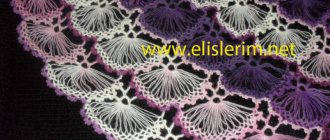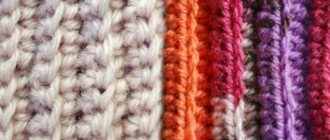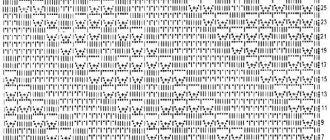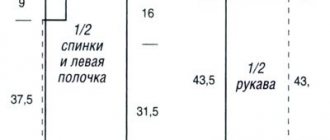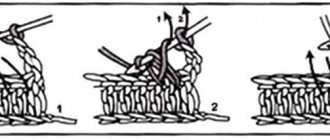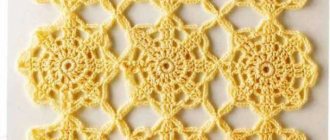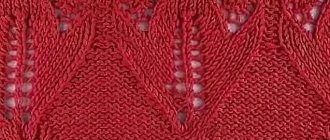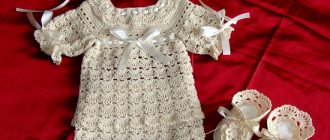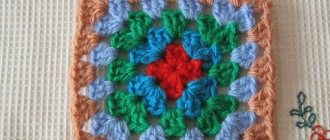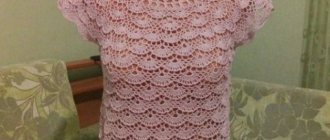Large tablecloth for the dining table using the fillet knitting technique
We will need:
- yarn “Iris” (100% cotton), 550 grams, beige;
- hook No. 1.5.
Scheme
Diameter: 120 cm.
Description
We crochet a chain of 8 sts. p., close it in a circle with the help of ss.. 1 r.: 4 in. p. lift, 4 unfinished s. with 2 n., connected together with the 4th century. p. lifter, into the resulting ring, 6 in. p., *5 unfinished p. with 2 n., tied together, in a ring, 6 c. p.*, from * to * x 4, total x 6, ss.. 2 p.: 5 c. p., 1 p. s n. in the 1st century. lift point, 7 p. s n. in an arch from the 6th century. p. previous p., *2 p. s n. in the next sec. from 2 n. previous p.. between s. s n. arch from 2nd century. p., 7 p. s n. into the next arch from the 6th century. p. of the previous row*, from * to * x 4, all x 6, ss.. 3 rows: 4 c. p., 4 p. from 2 n. in an arch of 2 c. p. prev. r.. 2 c. p., 1 p. from 2 n. in the 4th s. s n. previous river, 3rd century. p., 1 p. s n. in the 2nd s. s n. previous river, 2nd century. p., *5 s. from 2 n. into the next arch from the 2nd century. n. of the previous river, 2nd century. p., 1 p. from 2 n. in the 4th s. s n. Ave. R.. 3rd century. p., 1 p. from 2 n. in the 2nd s. s n. Ave. R., 2nd century n.*, from * to * x 4, total x 6, ss.. We continue further according to the previously provided scheme for the 35th r., each r. having finished ss..
Large scallop (x 6)
We attach a new thread, then straight and reverse pp. According to the diagram of a large festoon from 1 to 7 pp., cut off the thread.
Small scallop (x 6)
We attach a new thread, straight and reverse pp. according to cx. large festoon from 1 to 6 pp.. Tying Attach a new thread, knit in a circle picot according to diagram, finishing. ss..
Fillet knitting roses: master class
Fillet knitting a rose according to the pattern should begin with the choice of yarn:
- if the ornament is intended for a warm blouse, it is better to choose a thin acrylic or wool blend thread;
- For a light napkin or summer top, cotton with acrylic is suitable.
To prevent the knitting from being too loose, the yarn must match the hook number. Next you need to understand the diagram. If the pattern fits closely to its edges, you need to add 2 more cells on each side.
While working, you should pay attention to several points:
- pattern direction;
- front and back sides of the fabric;
- the border of each cell according to the diagram.
A free master class will help you understand the technique of knitting a flower:
Angel toy using fillet knitting technique
We will need:
- yarn “Iris” (100% cotton), about 15 grams;
- satin ribbon;
- form;
- padding polyester;
- hook No. 0.9.
Scheme
Height: 11 cm.
Description
Head
We crochet a chain of 5 v. p., in a circle using ss.. 1 r.: 1 v. p., 7 p. without n. in the ring, ss.. 2 r.: 1 in. p., 11 p. without n. in the village without n. pr. r., ss.. 3 r.: 1 v. p., 15 p. without n. in the village without n. pr.r., only 16 s. without n., ss..
We knit further according to cx. heads on the 12th row, do not cut off the thread. Fill the blank with padding polyester and tighten the remaining loops.
Torso
Nab. 8th century p., in a circle using ss.. 1 r.: 1 v. p., 8 p. without n. in the ring, ss.. 2 r.: 3 v. p., 1 p. s n. in the 1st century. p. lift pr. r., 2 s. s n. in the next With. s n. pr.r., only 18 s. s n., ss.. We continue according to cx. on the 6th r..
Skirt
Chain of 8 in p., in a circle ss.. Attach a new thread and continue working on cx. skirts, skipping in the first r. “wings” (sh. body), connecting the front and back of the bodice with the help of ss., continue along the 9th row, cut off the thread.
Assembly
By the 9th p.m. We sew a satin ribbon from the inside, and a loop of several stitches to the crown. p.. The angel should be starched and put on the uniform.
Volumetric knitting on fillet mesh
Now let’s make our work a little 3D - learn how to knit a three-dimensional pattern on top of a fillet mesh.
We will make the most ordinary mesh, and then we will knit double crochets into the cells - four for each edge. And with such waves from the columns we draw the drawing the way we want. We can make it geometrically correct, or we can make it fancy, we can use one color, or we can create a pattern with color.
For such products you will need thicker yarn, not napkin-tablecloth yarn, but as for ordinary knitted products: wool, wool mixture or synthetics. The hook, accordingly, should also be of a larger diameter, preferably according to the recommendations for the yarn.
Using this technique we can knit coasters, rugs, and furniture covers. The beauty of working in this technique is that here products can be knitted from leftover yarn.
If you liked this tutorial, don't forget to share it on social networks. And if you send us a photo of your work that you managed to do in this lesson, we will be very glad that everything worked out for you. Inspiration to you and your golden hands!
Decorative handbag for a baby using the fillet knitting technique
We will need:
- yarn “Iris” (100% cotton), 30 grams;
- form;
- hook No. 0.9.
Scheme
Size: 11 x 15 cm.
Description
Donyshko
We crochet a chain of 67 v. p.. 1 p.: 1 s. s n. in the 7th p., * 1st century. p., 1 p. s n. in the 2nd century. p. chain*, from * to * x 29, total x 31 cells, ending. R. With. s n.. 2 r.: 4 v. p., *1 p. s n. in the 1st s. s n. Ave. R., 1st century p.*, from * to * x 29, total x 31, ending. With. with n.. We knit straight and reverse pp. using the “loin knitting” technique according to cx. until 13 p.m. inclusive. 14 r.: knitting. in a circle with from N., 3rd century. p., 187 p. s n. in the village s n. and c. p.p.r., finishing. R. ss.. 15 r.: all s. s n. divide into 4 parts (63 s.n. for the front and back parts and 31 s.n. for the side parts). From 16 to 36 p.m. knitting in a circle according to cx. bags and side parts, each p. ends with ss..
Assembly
The product should be well starched, put on the form and left in this form until completely dry.
Scheme
Patterns for fillet knitting are different from those we are used to when crocheting. They do not contain the number and types of columns, but only show information about filling the cells. Often on diagrams, an arrow indicates where the work should be read from; next to the arrow in parentheses, the number of air loops in the initial chain is indicated.
Regular crochet pattern
Pattern for loin knitting
- Empty cell
- Filled cell
- Curly mesh
And from such a seemingly simple set, extraordinary beautiful works are obtained that can decorate any interior, as well as openwork items of clothing - for example, dresses and tunics.
Crochet napkin for beginners: “colored fillet knitting” technique
We will need:
- Vita cotton “Pelican” yarn (100% cotton), 25 grams white;
- Vita Cotton yarn “Iris print” (100% cotton), 13 grams red melange and green melange;
- hook No. 1.25.
Scheme
Size: 45 x 34 cm.
Description
Use a white thread to make a chain of 64 v. p.. 1 p.: 1 s. s n. in the 7th century. n., *2 v. p., 1 p. s n. in the 3rd century. n.*, from * to * x 18, 2 in. p., 1 p. from 2 n. at the base of the previous s. from n.. Total – 21 phil. cell.
We continue to work with direct and reverse pp. according to cx. up to 77 rub. inclusive, we do not cut the thread. At 10 p.m. we attach a thread in red tones, and in 15 - in green, changing the colors of the threads according to cx. drawing. Cut off the colored threads.
Harness
Knitting in a circle with s n. with white thread, we finish the r. ss.. The finished product should be starched and left to dry in a horizontal position.
Fillet knitting of small roses
Knitting small roses using the fillet method gives wide scope for creativity:
- use elements in the decoration of blouses and tops;
- put the motif in a separate strip - longitudinal or transverse;
- create an interesting composition from multi-colored roses;
- decorate the product with a wavy border.
Before you start knitting, you need to count the number of cells in the pattern. Each cell corresponds to 2 VP and 1 VP, so the initial chain is calculated by the formula: number of cells * 3 + 1 VP.
Read
Crochet Stesha doll: patterns and description of knitting
Next, the rose is knitted according to the pattern:
- for empty cells – 2 VP;
- in filled cells – 2 CCH;
- between them - 1 dc.
The process of knitting roses can be seen in detail in the video.
The material in this article will help you learn how to cross-stitch napkins according to the pattern.
DIY lightweight summer cardigan for beginners
We will need:
- yarn (55% cotton, 25% polyamide, 20% silk), 600-700 grams black;
- hook number 3.
Scheme
Sizes: 36-38.
Openwork pattern: a combination of mesh and dense areas in a checkerboard pattern.
Description
We dial the number of stitches we need, a multiple of 12 + 1 edge. 1 r.: 4 v. p., 1 p. s n. in the 6th century. p., 1st century p., s. from N., 1st century. p., 7 p. from N., 1st century. p., s. s n. etc., that is, we alternate 3 empty cells with filled ones). We finish 7 s. s n.. 2 r.: 3 v. p., 5 s. with n., 3 empty cells (we knit with n. not in s. with n. pr. r., but under v. p., i.e. the grid is shifted), 7 s. s n. etc. We finish the row with 3 empty cells + s. s n. in the last step of lifting, pr. r.. 3 r.: 3 in. p., 2 p. with n., then according to the picture. Zach. R. 4 s. s n.. 4 r.: 3 v. lift point, 1st century p., s. from N., 1st century. p., 7 p. with n., 3 empty cells, etc.. Zak. R. 1 empty cell. 5 p.: 3 v. p., 7 p. with n., 3 empty cells. Zach. R. 2 empty cells + 1 s. s n. in the last p. lifting pr. r.. 6 r.: 3 empty cells, 7 s. s n. etc. Zak. R. 7 p. s n.. Repeat these 6 r. until the desired length is reached.
Filling the grid with a pattern
To make a pattern on a grid, you can use a pattern designed for embroidery on canvas. Canvas is similar to fillet, but its cells are smaller and denser. Schemes have been published in large quantities on the Internet, on sites with handicraft themes.
You can develop simple schemes yourself. To do this, you need to take a notebook in a box and, coloring in the squares, draw a shape (circle, heart, oval, asterisk). Active users of office programs can create a diagram of any complexity on a computer, coloring the future drawing in specified colors.
Empty cells are filled using double crochets. They are knitted for each loop at the base of the cage. This means that the hook should not be inserted into the buttonhole itself, but should be caught in the lower sequence of air loops. In this version, the canvas looks more neat and smooth.
Spacious tunic for summer
We will need:
- yarn (100% polyamide), about 800 grams;
- hook No. 2.5.
Diagrams and symbols
Size: 40-42.
Border 51 p. wide: knit according to c. between arrows A and B; perform 1 to 5 pp. once, then repeat 2-5 pp..
Openwork pattern: knit according to pattern; we start with loops from arrow A, repeat the repeat stitch, finish the stitch to arrow B. Repeat p. - see border.
Right extreme motive: according to c. between arrows A and C, repeat p. - see border.
Left extreme motive: according to cx. between D and B. Repeat p. - see border.
Floral motif: fillet knitting according to the pattern. For 1 filled square, make 3 s. s n., for 1 empty – 1 s. s n. and 2nd century n.. Every r. We start with what is indicated in cx. number of p. lifting instead of 1st s. s n., finish 1 s. with n..
Description
Plank
We make a chain of 51st century. p. + 3 v. n. lifting, we make a border. After 58 cm we finish the work.
Before
We need to knit 168 stitches on the right side of the half border: 10 stitches of the right outer motif, 148 stitches of the floral motif, 10 stitches of the left motif. We look at the decreases for the neckline according to cx. After 50.5 cm we finish the work.
Back
On the right side of the remaining half of the border. We perform 147 stitches in openwork. After 50.5 cm we complete the work.
Mittens
Knitting border along a chain from the 51st century. p. + 3 v. lifting point. After 52 cm we finish.
Assembly
We make shoulder seams. We sew in the sleeves, aligning the middle of the sleeve with the shoulder seam, and sew the side seams and sleeve seams. Then we need to knit the neckline: 1 p.: *1 p. s n. over 1 s. s n. loin. grids, 2 in. p., skip 1 cell, from * to *. 2 p.: *1 p. without n. behind the arch from the. p., 5 s. s n. for the next arch from in. p., from * to *. In the same way we tie the lower edge of the tunic and sleeves.
What is fillet mesh and why doesn’t everyone succeed?
If you look at a selection of photos of fillet mesh, its widespread use becomes obvious. This is a completely independent openwork for summer handicrafts and an excellent basis for other types of needlework.
The pattern itself is very simple - alternate 1 double crochet stitch and 2 chain stitches, then again a double crochet stitch and 2 chain stitches, and so on until the end of the row. Then we turn and knit in exactly the same way, only be sure to knit the base from the top of the lower columns, and not from the chain loops.
You should get square windows. This is the answer to those who have trouble crocheting fillet mesh patterns.
Probably, beginners make typical mistakes in their work:
- knit one air loop between the columns, then when filling the narrow cells the pattern merges;
- too long stitches with 1 or 2 crochets distort the proportions of the squares;
- the hook is inserted into the free gap, covering the air loops, then an openwork resembling a honeycomb is obtained, it is beautiful, but not a loin mesh at all.
So, it is already clear that a typical French mesh or “loin” (as needlewomen call it) is knitted in squares. The basis, which came to us from the Middle Ages and became widespread, has many modern variations.
Note! Knitting vests - patterns for stylish patterns for children and adults. 165 photos of modern vests with detailed descriptionsSummer tunic-dress in the Givenchy style for beginners
We will need:
- yarn “Micro” (100% acrylic), 400 (450/500) grams;
- cr. No. 3.5.
Diagrams and symbols
Sizes: 36/38 (40/42) 44/46
Description
We alternate patterns 1 and 2. The product is knitted across, front and back - in one part. We dial 144 v. p. (= 6 rapports) + 3 v. lifting point, 9 r. u. 1, then y.2: 1 p. (purl): p. without n.. 2 r. (facial): 48 s. from 3 n., 36 p. from 2 n., 36 p. from 1 n., 24 half-columns. For the first armhole of the sleeve on the left side in the 2nd r. u. 2 we recruit 48 new v. p. and on them in the next R. (= 3rd r., purl) do with. without n., on the remaining s. pr.r. we make half columns.
Now we do 9 rubles again. u. 1 and 2 r. u. 2, in the 3rd r. for the neckline, leave 18 s unknitted. without n., knitting 9 rub. u. 1 and 2 r. u. 2, in the 2nd r. for the cut, leave without knitting for 30 s. without n., again 9 rubles. u. 1, in the 1st r. we are recruiting new 30 in. P..
For the neckline we dial 18 new stitches. p., 3 r. u. 2 and 9 r. pattern 1, 3 r. pattern 2, in the 2nd r. for the second armhole of the sleeve on the left side we leave 48 s unknitted. without n., 9 rub. pattern 1, 3 r. pattern 2, in the 2nd r. dial 48 new call. p., *knitting 9 . pattern 1 and 3 r. pattern 2, repeat x 2 from *, 9 r. pattern 1, finish with three p. pattern 2, in the 2nd r. leave unknitted 48. without n..
Assembly
We stretch the product according to the pattern and dry it under a damp towel. We close the side seam, tie the neckline and armholes with 1 p. With. without n..
Scheme of a fillet curtain with roses
Making a curtain is not a difficult task. You don’t have to look for ready-made patterns specifically for curtains, but take elements of a pattern for a napkin as a basis or make the product in the shape of a rectangle and then tie it with a border. Curtains often depict:
- butterflies;
- cats;
- sunflowers;
- tulips.
Read
Crochet fillet border: diagrams with descriptions
But the crocheted patterns of fillet roses on the curtain look especially beautiful.
An openwork curtain will be an elegant addition to the interior.
Stylish beach tunic. Filet knitting for beginners.
We will need:
- yarn (55% silk, 45% cotton), 500 (550) 600 grams;
- cr. No. 3.5;
- 2 leather laces, 100 cm each.
Scheme
Pattern
Sizes: 36/38 (40/42) 44/46
Main connection: p. s n.. Every r. we start from the 3rd century. p. instead of 1 s. With. n., and finishing. 1 p. s n. in the last V. p.p.r..
Sirloin knitting: number of sts. 2 + 41. We work according to the plan.. Beginning. with st. before rapport A, rapport A constantly repeated, perform 1 st. between rapport A and C = rapport. B. Rapp. C repeat when finished. p. after rap. C.
We perform 1–15th rows once, then 2–15th rows. constantly repeating..
Lattice: do it crosswise on an odd number of stitches. 1 p. from N., 1st century. p., finishing. 1 p. with n..
Description
Back
Chain of 95 (103) 111 v. p. + 3 v. p. lifting and for the bar 3 cm = 3 r. basic knot.. We continue to work: we start from the point before the rap. A, issue. 4 (6) 8 times rap. A, 30 p. rap. B, vol. 4 times rap. C, 30 p. rap. B, 4 (6) 8 times C, ending. p. after C.
After 14 cm from the bar, knit. on both sides the first and last 5 stitches (see loin knitting). Having knitted 58 (56) 54 cm from the placket, we skip 8 p. for the armholes on both sides = 79 (87) 95 p. After 76 cm from the placket, order. work.
Before
Like a back, but with a neckline and neckline: after 31 cm from the placket, we knit the middle 5 sts. knots, on both sides of them we continue to work as usual. In the words 2 r. expanding the basic knot on both sides by 1 p. respectively. After 34 cm from the plank, we divide the knitting in half, to do this we double the middle loop. First, we continue to knit the right half at 48 (52) 56 p., last. 5 sts before starting the cut. basic knot Decrease for the armhole along the right edge - as on the back = 40 (44) 48 sts. After 24 cm, skip 8 sts for the neckline along the left edge and for rounding in each row. R. 1 x 4 p., 2 x 3 p., 2 x 2 p. and 4 x 1 p.. At 22 (26) 30 p. slave. 76 cm from the plank. We make the left part mirror the right.
Sleeves
For each of the sleeves knit. chain of 67 (71) 75 v. p. + 3 v. p. lifting and for a plank 3 cm = 3 r. basic knot.. We continue fillet knitting, while starting from the point before the rap. A, rap.t A constantly repeat, close. p. after C. For bevel of sleeves + on both sides in every 8th r. from the plank 3 x 1 p. (in each 4th p. 5 x 1 p.) in each. 3rd r. 7 x 1 p. acc. Uz. = 73 (81) 89 p. 27 cm from the strip. knitting
Assembly
We sew the tunic along the shoulders, sew in the sleeves, make side seams and sleeve seams. We tie 3 r. around the neck. With. with n.. We thread the leather laces crosswise.
Elegant blouse with delicate roses, crocheted
A business jacket made using the loin knitting technique has an openwork appearance, thanks to which it will noticeably make you stand out from the crowd or work team. You won't feel hot in this blouse in the summer because it is highly breathable.
Finished product size 44-46. For knitting, we need to prepare 240 g of white cotton yarn Altin Basak Cordonnet, 50 g of white cotton yarn “Maxi”, 3 white buttons, as well as hook No. 1.
Using Altin Basak Cordonnet yarn we cast on a chain of 316 air loops, after which we divide it into 3 working sections as follows: 78 front loops, 160 back loops, 78 front loops. We knit 74 rows of the back with a fillet net, and the fronts with a pattern according to pattern 1. Divide all knitting into the back and fronts, and then perform each part separately.
To make an armhole, you need to close 6 loops, decrease 4 loops once, 3 loops once, 2 loops once, and then 1 loop. We finish the back at a height of 58 cm from the cast-on edge. To decorate the neck of the shelves, at a height of 55 cm from the cast-on edge, close 9 loops, and then decrease 2 times 4 loops, 2 times 3 loops, 2 times 1 loop.
Let's move on to knitting the sleeves. Using Altin Basak Cordonnet yarn, we cast on a chain of 90 loops, and then perform 65 rows according to scheme 1. To create a rollback, we close off 6 loops on both sides, decrease 3 times by 3 loops, 6 times by 2 loops, 10 times by 1 loop, and on height 52 cm we finish the work.
Assembly and finishing. Sew the shoulder seams. We also sew the sleeves and then sew them into the product. Using “Maxi” yarn we knit the cuffs in a half column 7 cm high. We also make the collar with this yarn. We cast on 110 loops along the neckline, knit 4 rows in a half-stitch. Then we close 5 loops on both sides and make 15 rows in a half-column. We tie the center of the shelves with 4 cm strips, making holes for fasteners.
The blouse is ready, all that remains is to sew on the buttons.
A selection of loin knitting patterns
Openwork top and blouse, crocheted using the fillet technique
Simple, airy blouses that can be worn anytime. They will be relevant both for everyday wear and at a party (if knitted with lurex thread).
Model size – 44
For work we will need 200 g of cotton yarn, as well as a hook No. 1,2
According to pattern 19, you need to knit all the details of the back and front, and also knit a pattern on the fillet mesh. When the parts are ready, they need to be sewn on the sides and shoulders. At the end of the work, tie the edges with a single crochet.
We knit a blouse in the same way. According to scheme 20, we make the details of the back and front with a pattern, then we sew the elements together. On the sleeves, tie a mesh of stitches with 3 double crochets and 3 air loops. Tie the edges of the product with a single crochet and decorate it with fringe and beads.
Openwork blouses look gentle and elegant. They give the girl an elegant look. Thanks to the fillet technique, you can knit any pattern on the mesh that will highlight the individuality of the hostess.
You can experiment not only with the pattern and color of the thread, you can also select different combinations of clothes with which the blouse will harmonize. What is needed for that? Knit this wonderful wardrobe item. So patience and inspiration, to you!
Two-color crocheted blouses made of loin mesh with stripes
Two-color fillet knitting of a sweater is a special method of crocheting in which an additional thread of the second color is not knitted, but placed in an air loop. At the same time, gaps remain (a kind of hemstitch) and the product turns out to be light and breathable.
On YouTube you can find videos on how to make a two-color crocheted fillet patchwork for a summer jacket. The knitting pattern for a sleeveless vest in this style is presented below.
For size 42-44 you need 240 grams of thread in the main color and 20 grams of thread for finishing, hook number 2. Knitting density - 34 loops and 15 rows in a square of 10 by 10 cm.
- For the back, knit a strip of 155 chain stitches and remove 8 stitches from both edges 29 rows before the waist.
- Knit the collar separately. Along the edge, knit 3 rows of single crochets and 1 row in a crab step through an air loop.
- Sew the back and fronts, make 4 rows of single crochets on the edges of the armholes and again 1 row of “crawfish step” through an air loop.
- Along the bottom edge of the sleeveless vest, knit 9 rows of single crochets, finish with 1 common row of “crawfish step” through 1 air loop along the sides and bottom edge.
- To make a hanging fastener, step back 15 loops from the bottom edge and tie a placket to the left side with 3 rows of double crochets.
Read
Master class for beginners: crochet dress for Barbie doll
You can learn the technique online using a video from needlewoman Galina Belikova.
Video: technique of knitting two-color fillet mesh
Crochet loin jackets according to patterns from Japanese magazines
In clippings from Japanese magazines you can find a lot of materials about fillet crochet, patterns for free. Asian-style summer sweaters from the selection below will turn out to be especially stylish and light.
Loose sports jumper
This lightweight jumper is perfect for everyday wear in the summer.
- Cast on a strip of 274 chain stitches and join the edges.
- Knit the back and front according to the patterns, decreasing the loops for the armholes and necklines. The fillet mesh is knitted through one air loop.
- Tie the sleeves together.
- Knit the elastic band, trims, and collar separately using knitting needles.
When all the parts are ready, connect them.
Coffee blouse
A coffee blouse with a rose and raglan sleeves without seams is suitable for both everyday work and festive moments.
- To get started, cast on two strips of 156 chain stitches.
- Knit two halves separately: the front - using a rose pattern, the back - with diamond patterns.
- Knit sleeves and armholes according to the patterns.
- Tie the neck with double crochets.
When the two halves are ready, connect them. Attach a brooch in the color of the threads in the form of a rose or other textile applique.
Loose top
For beginner needlewomen who are interested in a summer jacket with a crochet fillet pattern, the patterns for this top are quite simple. The special feature of the model is short sleeves in the batwing style.
- Cast on two strips of 145 chain stitches for the back and front.
- Knit the two halves separately with the pattern according to the patterns, adding loops to the sleeves and decreasing to the neck according to the patterns.
- Connect the two halves.
Using the presented patterns, you can also knit a jumper, beach dress, jacket or cardigan.
For those who practice loin crochet, patterns and descriptions of summer blouses will help you create a unique look almost free of charge.
